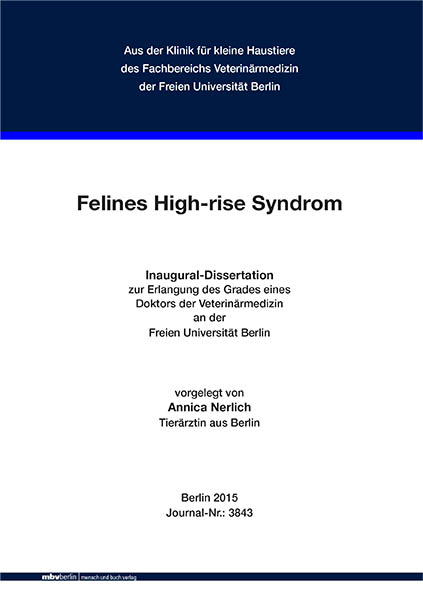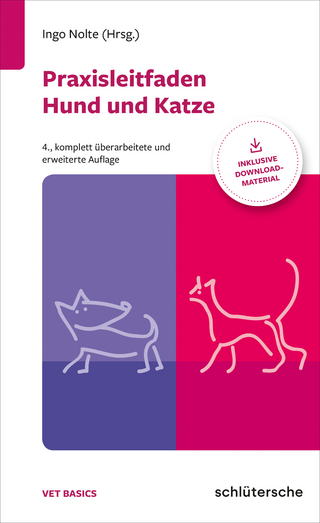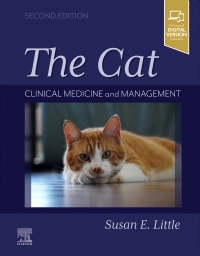
Felines High-rise Syndrom
Seiten
2016
|
1. Aufl.
Mensch & Buch (Verlag)
978-3-86387-770-5 (ISBN)
Mensch & Buch (Verlag)
978-3-86387-770-5 (ISBN)
- Keine Verlagsinformationen verfügbar
- Artikel merken
"Feline high-rise syndrome"
In the present retrospective study, feline HRS was analyzed in 1125 patients presented in the years 2004 to 2013 at the Small Animal Clinic of Freie Universität Berlin.
Signalment:
82 % of the animals were European Shorthair cats, 3.7 % were crossbreeds and 0.1 % rare breed animals. The patients were, on average, 2.3 years old, 27.3 % were younger and 72.7 % older than one year. 54.1 % of the animals were male and 45.9 % female. 62.9 % of the males were neutered and 21.9 % of the females were spayed. The body weight of all animals averaged 4.1 kg.
Course of the accident:
time of the year/time of the day: 77 % of the animals fell during the warmer/warm season, i.e. from April to September and 23 % in the colder/cold season, i.e. from October to April. 62 % of the animals fell at night and 38 % fell during the day.
Height of fall:
47 % of the cats in the study fell from high-ceilinged, pre-World War II buildings and 53 % from low-ceilinged, post-war buildings. Most of the falls were from the fourth (31 %), third (29 %), second (18 %) and fifth (11 %) floors. This corresponded to 12 m (31 %), 16 m (26 %), 8 m (22 %), 5 m (12 %) and more than 20 m (10 %).
After such falls, cats suffer from a variety of characteristic injuries including chest trauma, orofacial lesions, abdominal trauma and fractures in combination with other lesions.
The cats in the study suffered circulatory shock (48.6 %), craniocerebral injury (2.8 %), one or more chest traumas (58.3 %), one or more orofacial lesions (51.1 %) and blunt abdominal trauma (14.6 %). The musculoskeletal system was injured by the falls in 1040 patients, which included one or more fracture(s) of limb(s) (47.2 %) and of the pelvis (11.1 %), luxation of limb(s) (12.1 %) and ligament rupture(s) (1.5 %), soft tissue injuries of the limbs (8.2 %) and vertebral fracture(s) and/or vertebral luxation(s) (4.8 %). 3.7 % of the cats recovered from the fall uninjured, 25.2 % had minor, 25.1 % moderate, 20.2 % severe, non-life-threatening and 25.9 % severe, life-threatening injuries. 87 % of the cats survived. 71% of those were moderately to severely injured. 150 (13.3 %, N = 1125) of the patients eventually died in the clinic due to multiple traumas (n = 55; 36.6 %), or were euthanized at the request of their owners because of multiple traumas and a poor prognosis (n = 79; 52.6 %) or anticipated high treatment costs (n = 16; 10.6 %).
A significant correlation was determined between the severity of the injury, the consistency of the impact surface and the height of fall. Cats that had fallen on a hard surface were more seriously injured. They were also more seriously hurt if they fell from greater heights.
Slightly injured cats are usually polytraumatized with mouth bleeds, carpal ligament lesions and/or metacarpal fractures, mandibular fractures or epistaxis, hard palate fractures and dental trauma and one or more facial abrasions. Seriously injured cats present with pulmonary contusion, shock and pneumothorax in addition to the miscellaneous lesions from the slightly injured category.
The following injuries: shock, craniocerebral injury, pulmonary contusion, pneumothorax, haemothorax, pneumomediastinum, subcutaneous emphysema, mandibular fractures, rupture of the urinary bladder, spinal trauma, radial/ulnar fractures, carpal and metacarpal fractures, pelvic fractures and tibial/fibular fractures are significantly more likely to be diagnosed in direct proportion to the height of the fall. In der vorliegenden retrospektiven Studie wurde das feline HRS bei 1125 Patienten, die in den Jahren 2004 bis 2013 in der Klinik für kleine Haustiere der Freien Universität Berlin vorgestellt wurden, analysiert.
Signalement:
82 % der Tiere waren Europäisch Kurzhaar Katzen, 3,7 % Mischlinge und 0,1 % seltene Rassetiere. Die Patienten waren im Durchschnitt 2,3 Jahre alt, davon 27,3 % jünger und 72,7 % älter als ein Jahr. 54,1 % der Tiere waren männlich und 45,9 % weiblich. Davon waren 62,9 % männlich- und 21,9 % weiblich kastriert. Das Körpergewicht der Tiere betrug im Durchschnitt 4,1 kg.
Unfallhergang:
Jahres-/Tageszeit: 77 % der Tiere erlitten den Absturz in der wärmeren/warmen Jahreszeit April bis September und 23% in der kälteren/kalten von Oktober bis April. Nachts fielen 62% und am Tag 38% der Tiere in die Tiefe.
Absturzhöhe:
47 % stürzten aus Alt- und 53 % aus Neubauten ab. Häufigste Absturzhöhen waren die 4. (31 %), 3. (29 %), 2. (18 %) und 5. (11 %) Etage. Das entspricht 12 m (31 %), 16 m (26 %), 8 m (22 %), 5 m (12 %) und mehr als 20 m (10 %). Nach einem Fenstersturz können bei Katzen eine Vielzahl charakteristischer Verletzungen in Form von Thoraxtrauma(ta), orofaszialen Läsionen, abdominal Traumata und Fraktur(en) in Kombination mit anderen Läsionen diagnostiziert werden.
48,6 % der Katzen dieser Studie erlitten einen posttraumatischen Schock, 2,8 % ein Schädelhirntrauma, 58,3 % ein oder mehrere Thoraxtrauma(ta), 51,1 % eine oder mehrere orofasziale Läsion(en), 14,6 % ein stumpfes Bauchtrauma. Das muskuloskelettale System wurde bei 1040 Patienten beim Absturz traumatisiert, bei 47,2 % durch eine oder mehrere Fraktur(en) der Gliedmaße(n), bei 11,1 % durch Beckenfraktur(en), bei 12,1 % durch Gliedmaßenluxation(en), bei 1,5 % durch Bandruptur(en), bei 8,2 % durch Weichteilverletzungen der Gliedmaßen. Bei 4,8 % kam es zu Wirbelfraktur(en) und/oder Wirbelluxation. 3,7 % der Katzen blieben beim Absturz unverletzt, 25,2 % waren geringgradig, 25,1 % mittelgradig, 20,2 % hochgradig, nicht lebensbedrohlich und 25,9 % hochgradig, lebensbedrohlich verletzt. 87 % der Katzen überlebten. Davon waren 71 % mittel- bis schwerstgradig verletzt. 150 (13,3 %, N = 1125) der Unfallopfer starben letztlich in der Klinik am Polytrauma (n = 55; 36,6 %), wurden deswegen und infauster Prognose (n = 79; 52,6 %) oder aber aufgrund zu erwartender Kosten (n = 16; 10,6 %) für die Therapie auf Wunsch der Besitzer getötet.
Es konnte ein signifikanter Unterschied zwischen dem Schweregrad der Verletzungen und der Beschaffenheit der Aufprallfläche sowie der Absturzhöhe festgestellt werden. Prallen Katzen auf einen harten Untergrund auf, sind sie schwerer verletzt. Sie sind ebenso schwerer lädiert, je größer die Absturzhöhe ist.
Leicht verletzte Katzen sind meist mit Maulblutung, karpalen Bandläsionen und/oder metakarpalen Fraktur(en), Unterkieferfraktur(en)oder Epistaxis, Gaumenspalte und Zahntrauma(ta) sowie einer oder mehreren Abrasionen des Gesichts polytraumatisiert. Schwerverletzt sind Katzen mit Lungenkontusion, Schock, Pneumothorax zusätzlich zum Läsionsbukett der Leichtverletzten. Die Verletzungen: Schock, Schädelhirntraum, Lungenkontusion, Pneumothorax, Hämothorax, Pneumomediastinum, subcutanes Emphysem, Unterkieferfraktur(en), Harnblasenruptur, Wirbelsäulentrauma, Radius- und Ulnafraktur(en), karpale und metakarpale Fraktur(en), Beckenfraktur(en) und Tibia- und Fibularfraktur(en) werden signifikant häufiger mit zunehmender Absturztiefe diagnostizert.
In the present retrospective study, feline HRS was analyzed in 1125 patients presented in the years 2004 to 2013 at the Small Animal Clinic of Freie Universität Berlin.
Signalment:
82 % of the animals were European Shorthair cats, 3.7 % were crossbreeds and 0.1 % rare breed animals. The patients were, on average, 2.3 years old, 27.3 % were younger and 72.7 % older than one year. 54.1 % of the animals were male and 45.9 % female. 62.9 % of the males were neutered and 21.9 % of the females were spayed. The body weight of all animals averaged 4.1 kg.
Course of the accident:
time of the year/time of the day: 77 % of the animals fell during the warmer/warm season, i.e. from April to September and 23 % in the colder/cold season, i.e. from October to April. 62 % of the animals fell at night and 38 % fell during the day.
Height of fall:
47 % of the cats in the study fell from high-ceilinged, pre-World War II buildings and 53 % from low-ceilinged, post-war buildings. Most of the falls were from the fourth (31 %), third (29 %), second (18 %) and fifth (11 %) floors. This corresponded to 12 m (31 %), 16 m (26 %), 8 m (22 %), 5 m (12 %) and more than 20 m (10 %).
After such falls, cats suffer from a variety of characteristic injuries including chest trauma, orofacial lesions, abdominal trauma and fractures in combination with other lesions.
The cats in the study suffered circulatory shock (48.6 %), craniocerebral injury (2.8 %), one or more chest traumas (58.3 %), one or more orofacial lesions (51.1 %) and blunt abdominal trauma (14.6 %). The musculoskeletal system was injured by the falls in 1040 patients, which included one or more fracture(s) of limb(s) (47.2 %) and of the pelvis (11.1 %), luxation of limb(s) (12.1 %) and ligament rupture(s) (1.5 %), soft tissue injuries of the limbs (8.2 %) and vertebral fracture(s) and/or vertebral luxation(s) (4.8 %). 3.7 % of the cats recovered from the fall uninjured, 25.2 % had minor, 25.1 % moderate, 20.2 % severe, non-life-threatening and 25.9 % severe, life-threatening injuries. 87 % of the cats survived. 71% of those were moderately to severely injured. 150 (13.3 %, N = 1125) of the patients eventually died in the clinic due to multiple traumas (n = 55; 36.6 %), or were euthanized at the request of their owners because of multiple traumas and a poor prognosis (n = 79; 52.6 %) or anticipated high treatment costs (n = 16; 10.6 %).
A significant correlation was determined between the severity of the injury, the consistency of the impact surface and the height of fall. Cats that had fallen on a hard surface were more seriously injured. They were also more seriously hurt if they fell from greater heights.
Slightly injured cats are usually polytraumatized with mouth bleeds, carpal ligament lesions and/or metacarpal fractures, mandibular fractures or epistaxis, hard palate fractures and dental trauma and one or more facial abrasions. Seriously injured cats present with pulmonary contusion, shock and pneumothorax in addition to the miscellaneous lesions from the slightly injured category.
The following injuries: shock, craniocerebral injury, pulmonary contusion, pneumothorax, haemothorax, pneumomediastinum, subcutaneous emphysema, mandibular fractures, rupture of the urinary bladder, spinal trauma, radial/ulnar fractures, carpal and metacarpal fractures, pelvic fractures and tibial/fibular fractures are significantly more likely to be diagnosed in direct proportion to the height of the fall. In der vorliegenden retrospektiven Studie wurde das feline HRS bei 1125 Patienten, die in den Jahren 2004 bis 2013 in der Klinik für kleine Haustiere der Freien Universität Berlin vorgestellt wurden, analysiert.
Signalement:
82 % der Tiere waren Europäisch Kurzhaar Katzen, 3,7 % Mischlinge und 0,1 % seltene Rassetiere. Die Patienten waren im Durchschnitt 2,3 Jahre alt, davon 27,3 % jünger und 72,7 % älter als ein Jahr. 54,1 % der Tiere waren männlich und 45,9 % weiblich. Davon waren 62,9 % männlich- und 21,9 % weiblich kastriert. Das Körpergewicht der Tiere betrug im Durchschnitt 4,1 kg.
Unfallhergang:
Jahres-/Tageszeit: 77 % der Tiere erlitten den Absturz in der wärmeren/warmen Jahreszeit April bis September und 23% in der kälteren/kalten von Oktober bis April. Nachts fielen 62% und am Tag 38% der Tiere in die Tiefe.
Absturzhöhe:
47 % stürzten aus Alt- und 53 % aus Neubauten ab. Häufigste Absturzhöhen waren die 4. (31 %), 3. (29 %), 2. (18 %) und 5. (11 %) Etage. Das entspricht 12 m (31 %), 16 m (26 %), 8 m (22 %), 5 m (12 %) und mehr als 20 m (10 %). Nach einem Fenstersturz können bei Katzen eine Vielzahl charakteristischer Verletzungen in Form von Thoraxtrauma(ta), orofaszialen Läsionen, abdominal Traumata und Fraktur(en) in Kombination mit anderen Läsionen diagnostiziert werden.
48,6 % der Katzen dieser Studie erlitten einen posttraumatischen Schock, 2,8 % ein Schädelhirntrauma, 58,3 % ein oder mehrere Thoraxtrauma(ta), 51,1 % eine oder mehrere orofasziale Läsion(en), 14,6 % ein stumpfes Bauchtrauma. Das muskuloskelettale System wurde bei 1040 Patienten beim Absturz traumatisiert, bei 47,2 % durch eine oder mehrere Fraktur(en) der Gliedmaße(n), bei 11,1 % durch Beckenfraktur(en), bei 12,1 % durch Gliedmaßenluxation(en), bei 1,5 % durch Bandruptur(en), bei 8,2 % durch Weichteilverletzungen der Gliedmaßen. Bei 4,8 % kam es zu Wirbelfraktur(en) und/oder Wirbelluxation. 3,7 % der Katzen blieben beim Absturz unverletzt, 25,2 % waren geringgradig, 25,1 % mittelgradig, 20,2 % hochgradig, nicht lebensbedrohlich und 25,9 % hochgradig, lebensbedrohlich verletzt. 87 % der Katzen überlebten. Davon waren 71 % mittel- bis schwerstgradig verletzt. 150 (13,3 %, N = 1125) der Unfallopfer starben letztlich in der Klinik am Polytrauma (n = 55; 36,6 %), wurden deswegen und infauster Prognose (n = 79; 52,6 %) oder aber aufgrund zu erwartender Kosten (n = 16; 10,6 %) für die Therapie auf Wunsch der Besitzer getötet.
Es konnte ein signifikanter Unterschied zwischen dem Schweregrad der Verletzungen und der Beschaffenheit der Aufprallfläche sowie der Absturzhöhe festgestellt werden. Prallen Katzen auf einen harten Untergrund auf, sind sie schwerer verletzt. Sie sind ebenso schwerer lädiert, je größer die Absturzhöhe ist.
Leicht verletzte Katzen sind meist mit Maulblutung, karpalen Bandläsionen und/oder metakarpalen Fraktur(en), Unterkieferfraktur(en)oder Epistaxis, Gaumenspalte und Zahntrauma(ta) sowie einer oder mehreren Abrasionen des Gesichts polytraumatisiert. Schwerverletzt sind Katzen mit Lungenkontusion, Schock, Pneumothorax zusätzlich zum Läsionsbukett der Leichtverletzten. Die Verletzungen: Schock, Schädelhirntraum, Lungenkontusion, Pneumothorax, Hämothorax, Pneumomediastinum, subcutanes Emphysem, Unterkieferfraktur(en), Harnblasenruptur, Wirbelsäulentrauma, Radius- und Ulnafraktur(en), karpale und metakarpale Fraktur(en), Beckenfraktur(en) und Tibia- und Fibularfraktur(en) werden signifikant häufiger mit zunehmender Absturztiefe diagnostizert.
| Erscheinungsdatum | 08.02.2018 |
|---|---|
| Verlagsort | Berlin |
| Sprache | deutsch |
| Themenwelt | Veterinärmedizin ► Kleintier |
| Schlagworte | Cats • Data Analysis • Falls • Fracture • Statistical Analysis • Trauma • Underground Structures • WINDOWS |
| ISBN-10 | 3-86387-770-5 / 3863877705 |
| ISBN-13 | 978-3-86387-770-5 / 9783863877705 |
| Zustand | Neuware |
| Informationen gemäß Produktsicherheitsverordnung (GPSR) | |
| Haben Sie eine Frage zum Produkt? |
Mehr entdecken
aus dem Bereich
aus dem Bereich
Clinical Medicine and Management
Buch | Hardcover (2024)
Elsevier - Health Sciences Division (Verlag)
199,95 €
Buch | Spiralbindung (2023)
Schlütersche (Verlag)
69,95 €


